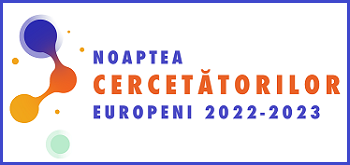| Articolul precedent |
| Articolul urmator |
 |
 801 801 19 19 |
| Ultima descărcare din IBN: 2024-04-12 10:12 |
| Căutarea după subiecte similare conform CZU |
| 547.1 (22) |
| Clasificarea compuşilor organici. Compuşi element-organici (16) |
 SM ISO690:2012 SM ISO690:2012GOROBEŢ, Anastasia, CRIŞAN, Manuela E., PETRIC, M., BOUROSH, Pavlina, CROITOR, Lilia. Structural study of Ca(II) AND Ni(II) coordination compounds with triethanolamine and 4-nitrobenzoic acid. In: Materials Science and Condensed Matter Physics, Ed. 9, 25-28 septembrie 2018, Chișinău. Chișinău, Republica Moldova: Institutul de Fizică Aplicată, 2018, Ediția 9, p. 119. |
| EXPORT metadate: Google Scholar Crossref CERIF DataCite Dublin Core |
| Materials Science and Condensed Matter Physics Ediția 9, 2018 |
||||||
|
Conferința "International Conference on Materials Science and Condensed Matter Physics" 9, Chișinău, Moldova, 25-28 septembrie 2018 | ||||||
|
||||||
| CZU: 547.1 | ||||||
| Pag. 119-119 | ||||||
|
||||||
| Rezumat | ||||||
Triethanolamine is known as a versatile coordinating agent with different metallic ions, showing a diversity of coordination modes [1]. Our previous study shows the important role of alkanolammonium salts as molecular building blocks in providing interesting supramolecular networks via hydrogen bonds [2]. The interaction in the system Ca(II)/Ni(II), organic salt trietanolammonium 4-nitrobenzoate (TEA)(4-nbz) [2] and TEA (TEA = triethanolamine, 4-nbz = 4-nitrobenzoic acid) resulted in colorless crystalline solids of coordination compound [Ca(TEA)2](4-nbz)2 (1) and blue crystals of [Ni(TEA)2](4-nbz)2 (2). Compound 1 crystallizes in triclinic P-1 (No. 2) space group: a=7.2948(5), b=8.9531(7), c=12.6963(9) Å, α=101.911(6), β=100.041(6), γ=97.548(6)°; while 2 in monoclinic P21/n (No.14) space group: a=13.5295(6), b=7.0717(2), c=16.5550(8) Å, β=106.555(5)°. The crystal structure of both compounds consist of the [M(TEA)2]2+ cation (figure) and 4-nbz– anions. Triethanolamine is known as a versatile coordinating agent with different metallic ions, showing a diversity of coordination modes [1]. Our previous study shows the important role of alkanolammonium salts as molecular building blocks in providing interesting supramolecular networks via hydrogen bonds [2]. The interaction in the system Ca(II)/Ni(II), organic salt trietanolammonium 4-nitrobenzoate (TEA)(4-nbz) [2] and TEA (TEA = triethanolamine, 4-nbz = 4-nitrobenzoic acid) resulted in colorless crystalline solids of coordination compound [Ca(TEA)2](4-nbz)2 (1) and blue crystals of [Ni(TEA)2](4-nbz)2 (2). Compound 1 crystallizes in triclinic P-1 (No. 2) space group: a=7.2948(5), b=8.9531(7), c=12.6963(9) Å, α=101.911(6), β=100.041(6), γ=97.548(6)°; while 2 in monoclinic P21/n (No.14) space group: a=13.5295(6), b=7.0717(2), c=16.5550(8) Å, β=106.555(5)°. The crystal structure of both compounds consist of the [M(TEA)2]2+ cation (figure) and 4-nbz– anions. In the complex cation [Ca(TEA)2]2+ of 1, the Ca(II) ion lies on a center of symmetry and is sandwiched by two bulky TEA ligands. Each TEA ligand adopts a tripodal conformation and acts as a tetradentate ligand through all three hydroxyl O atoms and amine N atom, resulting in an eight-coordinate calcium(II) ion. The mononuclear cation of 2 resides on a crystallographic inversion center and the structure formed by binding two TEA ligands with the Ni(II) that resulted in a six-coordinate environment around the metal. Each TEA acts as a tridentate ligand through the amine N atom and two hydroxyl O atoms. The intermolecular O–H···O and C–H···O hydrogen bonds link components in supramolecular railroad chains in 1 and network in 2. |
||||||
|
Dublin Core Export
<?xml version='1.0' encoding='utf-8'?> <oai_dc:dc xmlns:dc='http://purl.org/dc/elements/1.1/' xmlns:oai_dc='http://www.openarchives.org/OAI/2.0/oai_dc/' xmlns:xsi='http://www.w3.org/2001/XMLSchema-instance' xsi:schemaLocation='http://www.openarchives.org/OAI/2.0/oai_dc/ http://www.openarchives.org/OAI/2.0/oai_dc.xsd'> <dc:creator>Gorobeţ, A.</dc:creator> <dc:creator>Crişan, M.</dc:creator> <dc:creator>Petric, M.</dc:creator> <dc:creator>Bouroş, P.N.</dc:creator> <dc:creator>Croitor, L.M.</dc:creator> <dc:date>2018</dc:date> <dc:description xml:lang='en'><p>Triethanolamine is known as a versatile coordinating agent with different metallic ions, showing a diversity of coordination modes [1]. Our previous study shows the important role of alkanolammonium salts as molecular building blocks in providing interesting supramolecular networks via hydrogen bonds [2]. The interaction in the system Ca(II)/Ni(II), organic salt trietanolammonium 4-nitrobenzoate (TEA)(4-nbz) [2] and TEA (TEA = triethanolamine, 4-nbz = 4-nitrobenzoic acid) resulted in colorless crystalline solids of coordination compound [Ca(TEA)2](4-nbz)2 (<strong>1</strong>) and blue crystals of [Ni(TEA)2](4-nbz)2 (<strong>2</strong>). Compound <strong>1 </strong>crystallizes in triclinic <em>P</em>-1 (No. 2) space group: <em>a</em>=7.2948(5), <em>b</em>=8.9531(7), <em>c</em>=12.6963(9) Å, <em>α=</em>101.911(6), β<em>=</em>100.041(6), <em>γ=</em>97.548(6)°; while <strong>2 </strong>in monoclinic <em>P</em>21/<em>n </em>(No.14) space group: <em>a</em>=13.5295(6), <em>b</em>=7.0717(2), <em>c</em>=16.5550(8) Å, β=106.555(5)°. The crystal structure of both compounds consist of the [M(TEA)2]2+ cation (figure) and 4-nbz– anions. Triethanolamine is known as a versatile coordinating agent with different metallic ions, showing a diversity of coordination modes [1]. Our previous study shows the important role of alkanolammonium salts as molecular building blocks in providing interesting supramolecular networks via hydrogen bonds [2]. The interaction in the system Ca(II)/Ni(II), organic salt trietanolammonium 4-nitrobenzoate (TEA)(4-nbz) [2] and TEA (TEA = triethanolamine, 4-nbz = 4-nitrobenzoic acid) resulted in colorless crystalline solids of coordination compound [Ca(TEA)2](4-nbz)2 (<strong>1</strong>) and blue crystals of [Ni(TEA)2](4-nbz)2 (<strong>2</strong>). Compound <strong>1 </strong>crystallizes in triclinic <em>P</em>-1 (No. 2) space group: <em>a</em>=7.2948(5), <em>b</em>=8.9531(7), <em>c</em>=12.6963(9) Å, <em>α=</em>101.911(6), β<em>=</em>100.041(6), <em>γ=</em>97.548(6)°; while <strong>2 </strong>in monoclinic <em>P</em>21/<em>n </em>(No.14) space group: <em>a</em>=13.5295(6), <em>b</em>=7.0717(2), <em>c</em>=16.5550(8) Å, β=106.555(5)°. The crystal structure of both compounds consist of the [M(TEA)2]2+ cation (figure) and 4-nbz– anions. In the complex cation [Ca(TEA)2]2+ of <strong>1</strong>, the Ca(II) ion lies on a center of symmetry and is sandwiched by two bulky TEA ligands. Each TEA ligand adopts a tripodal conformation and acts as a tetradentate ligand through all three hydroxyl O atoms and amine N atom, resulting in an eight-coordinate calcium(II) ion. The mononuclear cation of <strong>2 </strong>resides on a crystallographic inversion center and the structure formed by binding two TEA ligands with the Ni(II) that resulted in a six-coordinate environment around the metal. Each TEA acts as a tridentate ligand through the amine N atom and two hydroxyl O atoms. The intermolecular O–H···O and C–H···O hydrogen bonds link components in supramolecular railroad chains in <strong>1 </strong>and network in <strong>2</strong>.</p></dc:description> <dc:source>Materials Science and Condensed Matter Physics (Ediția 9) 119-119</dc:source> <dc:title>Structural study of Ca(II) AND Ni(II) coordination compounds with triethanolamine and 4-nitrobenzoic acid</dc:title> <dc:type>info:eu-repo/semantics/article</dc:type> </oai_dc:dc>












